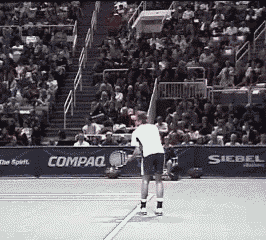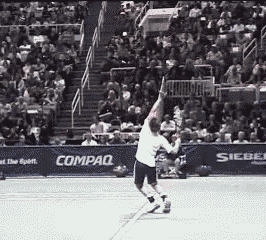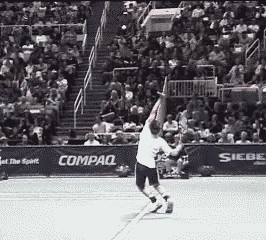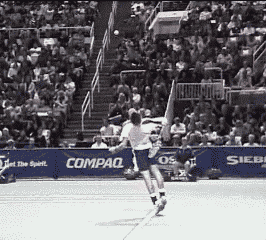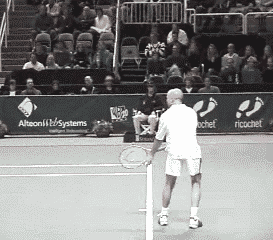|
TennisOne Lessons Andy Roddick’s 155 mph Serve, Part Two Bob Prichard
But flexibility is only one factor in service speed. When tennis players swing their racquets, they are essentially placing the racquet head in a small orbit around their body. The best way to get something into orbit is to use a multi-stage rocket. This is what NASA does. It launches multi-stage rockets to place its satellites into orbit. We can look at tennis players as a five-stage rocket, as you can see in this drawing. The first, most powerful stage is the legs. The legs drive the second stage, which is the rotation of the hips. The power, speed and momentum of the hips are then transmitted to the shoulders, which add their own power. Next, the arm rotates forward and the elbow extends, transmitting all the prior forces to the forearm and hand, which extends the racquet. Legs, hips, shoulders, arm, hand--the racquet head is now in orbit, transmitting all prior forces to the ball at impact. Coupled with good range, a correct sequential firing of the body stages produces an effortless, powerful serve.
Roddick has one of the only two strokes in tennis that are sequence efficient (the other was Lendl’s forehand). His serve, in this regard, is worthy of emulation. Let’s take a look at what he does. First, Roddick fires his legs. You can see that he extends his knees, but has not rotated any of his other stages. The knee straightening is not a powerful move in and of itself (if you tried to hit a ball with your head by straightening your knees, the ball would not go very far!). It is simply an indication that he is firing his leg muscles first, before he fires any of his other stages. The real value of the legs is that they drive the rotation of the hips. This is done by use of one of the biggest muscles of the body, the gluteals or butt muscles. Unfortunately, these muscles are very weak in most tennis players. In addition, most tennis players have very stiff hips. The combination of weak gluteals and stiff hips robs this powerful stage of its potential contribution to the serve.
Here is a simple test for your hip rotation flexibility and gluteals muscle strength. Lie on your stomach on the floor, with your legs together. Keeping your knees together, bend your knees 90 degrees so that the soles of your feet point toward the ceiling. Now move your feet away from each other as far as you can. You should have a minimum of 60 degrees of internal hip rotation on each leg, (our player shown here has only 35 degrees of internal hip rotation on each leg). If not, you should look into our Microfiber Reduction to increase this range. Once in this position, have someone hold your feet apart as you try to bring them together. Since your hip muscles should be stronger than anyone’s arms (compare the size of your butt to anyone’s shoulders and biceps), you should be able to easily bring your feet together. (Be careful doing this test. Don’t make it a contest of wills. If you can’t bring your feet together easily, gracefully accept you do not have sufficient strength in these muscles. We will show you later how to improve it. As with any exercise, consult with your physician before trying this test at home.)
If you flunked the flexibility or strength tests, and your serve is not as powerful as you want, you now know at least two reasons for its present state. So, the second stage of Roddick’s excellent launch sequence is the rotation of his hips. Unlike many players, he rotates his hips a full 90 degrees, and he rotates them quickly. Speed and range of rotation are the fuel of each stage. The more fuel, the more the stage contributes to the launch. Next, Roddick rotates his shoulders. To be honest, Roddick could do a better job of separating the rotation of his shoulders and hips. They are a little too close together. The more separation, the better the launch, just like at NASA. If you were launch engineer at NASA and fired two stages at once, you would probably not be invited back for the subsequent launch.
Next, Roddick fires his right arm, rotating his upper arm forward and extending his elbow. Notice at the end of his elbow extension, Roddick has not fired his hand at all. The racquet handle is still at 90 degrees to his forearm, the same position it occupied at the beginning of his serve. He fires his forearm muscles (which control the movement of his wrist and hand) in the last instant before impact. It is the sequential summation of all these forces, and his exceptional range, that enables Roddick to execute the fastest serves in tennis history. To be an exceptional player, you must have exceptional range and sequence. Since tennis is played with the body, if you want to change your game, you have to change your body. This does not mean lifting weights or running (which make your body stiffer and the stages less able to separate). It means increasing your range and improving your sequence.
This sequential firing of each stage is what happens in an efficient launch. Unfortunately, tennis players are not rocket scientists, and do not execute good launch sequence protocols. Many fire their parts out of sequence. Others fire all parts at once. Just as this would be disastrous at Cape Kennedy, so it is unproductive on the tennis court. You won’t lose your job like you would at NASA. You just lose your pride and/or paycheck. This lack of efficient sequence in tennis players may be the reason NASA employs so few tennis players as launch engineers. Below (Andre Agassi) is an example of what we mean by poor sequence. Agassi gets off to a good start (despite his limited external arm rotation) with his knees bent, hips and shoulders rotated away from the ball. He fires his legs first, and then rotates his hips. But before he completes his hip rotation he fires his shoulders which then rotate ahead of his hips. He also does not rotate his hips a full 90 degrees before impact. This abbreviated rotation and poor sequence between stages two and three robs Agassi of a powerful serve. If he launched rockets at Cape Kennedy like he launches his serves, our space program would be in deep trouble. We are not picking on Agassi. Most tennis players fire out of sequence. It’s why they can’t match Roddick’s service speed.
How can you improve your sequence? First, put your serve on videotape. Tape yourself from the side, with the shutter set at 1/1,000 th of a second, and play the tape back frame by frame. Carefully analyze your sequence and compare it to Roddick’s. While you are at it, measure your maximum external arm rotation. If you fire your upper body early (the most common serve fault), we have a solution for you. Since the tendency of tennis players is to fire the shoulders, arm and hand first, to improve your sequence you need to concentrate on Stage 1 and 2—the legs and hips. There is only one machine that will do that—the Somax Power Hip Trainer. The Somax Power Hip Trainer provides the critical resistance you need to improve the strength and speed of your hip rotation. By resisting the rotation of the hips, it helps you to learn to drive your hips with your legs. Tennis players at our clinic in Tiburon, CA, have increased their racquet head speed from 55 to 85 mph after just 30 minutes on our Power Hip Trainer. The hip trainer not only helps with sequence and separation (we demonstrate special separation drills in the 90 minute DVD that comes with your hip trainer), but also helps you to improve the speed of your hip rotation. Remember the equation F=ma, force equals mass X acceleration that you learned in high school physics class? Your hips have much greater mass than your arm. When you can accelerate a greater mass, you produce much more force. This is why great baseball batters have such big butts—they are accelerating bigger masses. Training with the Power Hip Trainer will turn your butt from a liability to an asset. With better range, sequence, separation and speed, you will be well on your way to humiliating your opponents with punishing service speed. What could be sweeter? In our next article, we discuss the origins of lower back pain in tennis players. It has nothing to do with disks or other lower back problems. © Bob Prichard 2006 Your comments are welcome. Let us know what you think about Bob Prichard's article by emailing us here at TennisONE.
Bob Prichard is President of Somax Sports Corporation in Tiburon, CA. Its athletes have won 44 Gold Medals and set 11 World Records. Mr. Prichard can be contacted through the Somax Sports web site at www.somaxsports.com |

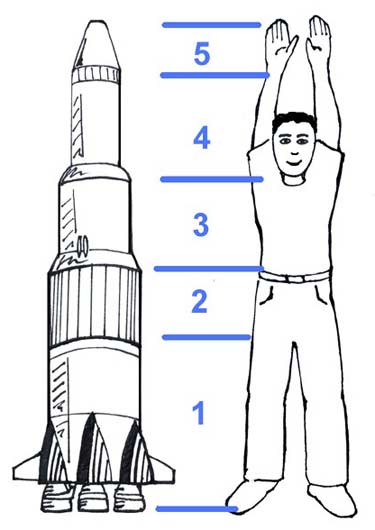 In our
In our 